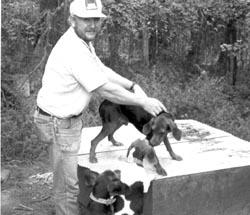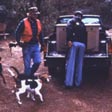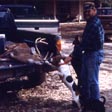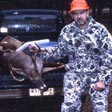Deer Hunting with Dogs
By Terry L. Jones
The huge buck came loping out of the overgrown clear cut field into the flooded glade, exploding the water into sheets of spray as it pounded through. T-Bone Junior and Boy, two black and tan hounds, were close behind, bawling coarsely as they closed in on their game.
From atop a leaning tree, Paul Green, the dogs' owner, watched nervously as the whitetail bounded straight for him, its huge rack swaying from side to side. Fingering his twelve gauge, he cut down on the buck with a round of buckshot as it suddenly swerved to the left to re-enter the thicket. Three times Paul fired as the deer bounded over the briars. Then it stopped. Seeing only massive antlers above the brush, Paul slipped in a "bear ball," took the best aim he could at the hidden deer and touched off a fourth shot. The buck only jumped and stopped again. Another ball was fed into the shotgun and fired. Then a third. But that was all, for Paul had no more shells.
With the crying hounds nearly on top of the buck, the ghostly antlers rose and fell as the deer struggled to stand. Leaping twelve feet to the ground, Paul raced across the hundred yards of shallow water to find T-Bone Junior and Boy nipping at the buck as it quickly died. It was a deer like which few of the hunters in this part of Winn Parish had ever seen. With twelve points and a twenty-four inch spread, the massive buck later weighed in on a butcher's scale at 305 lbs. T-Bone Junior and Boy had bagged a trophy.
Dog hunting for deer is a Louisiana sport older than the state itself and one that infects the hunter with an excitement and obsession few others can match. Since Louisiana is largely covered with thickets, canebrake, and dense timber, hunters have used hounds to chase down or tree their game ever since the French first settled here in the eighteenth century. Squirrel dogs, bear hounds, and mongrel mutts were as common around Louisiana homesteads as barefooted kids. But deer hounds held a special place in the heart of the hunter, for deer were plentiful, made excellent eating and provided the exciting races that were essential to a good hunt.
Unfortunately, in many parts of the state, especially the piney hills of North Louisiana, deer populations dwindled as a result of year-round hunting pressure and destructive logging practices. By the 1920s deer became nearly extinct in many parishes and the faithful deer hounds faded with them, supplanted by squirrel and rabbit dogs as the hunter's best friend.
It was not until the 1950s that a rebirth of dog hunting for deer occurred. At that time, parish police juries largely controlled hunting seasons and many took steps to restock the deer herds. In the early 1950s, for example, Winn Parish brought in deer trapped from Tensas and Madison parishes, and from as far away as Wisconsin, in an attempt to rebuild the herds. The experiment was a success, and in 1956 Winn Parish opened its first deer season: a one day, one buck affair. Through careful management and the creation of prime deer habitat by second growth timber, the deer population in Louisiana exploded in the 1960s. With the new deer herds came the re-emergence of dog hunting as old timers who had killed their last deer forty years earlier taught their children and grandchildren the traditional ways of hunting deer.
Bobby Joe Chandler, of Winn Parish, is typical of this second generation of dog hunters. Having learned the sport from older friends and family members, he has kept as many as twenty-five hounds, though today he finds four enough. "For anybody that's never heard a pack of good running deer hounds running a deer on a good frosty, cold morning," he asserts, "if that don't get your heart to thumping, you ought not to be deer hunting anyhow."
Paul Green agrees and compares dog hunting with bass fishing. "You get people who like top water bait for the anticipation and excitement. Others like underwater baits, and the feel of it." Still, hunting, he says, is like the latter; it takes a slow, methodical approach, much like fishing with an artificial worm. But dog hunting is all flash, with the excitement of hearing a good race and the adrenalin pumping in anticipation of waiting for the deer to bound into view.
Attaining this level of excitement requires a good pack of dogs. Traditionally deer dogs were long-legged walkers, blueticks or redbones; dogs that could push a deer all day and cover a vast territory. Today, however, the trend is to smaller dogs, such as beagles and short-eared black and tans. With the hunting territory being parceled out in ever smaller hunting leases, dogs that run slower, cover less ground and are easier to catch better fit into the new type of hunting conditions. Feeding the smaller ones is easier too, for dog hunting can be expensive. A hunter may spend hundreds of dollars a year just to feed his hounds—all for a three week season.
Though leasing has made some changes in the types of dogs used, dog hunting itself remains much like it was one hundred years ago. Standers, hunters assigned to stay in a specific spot, are placed at known deer crossings on pipelines, old logging roads and in the open woods. The driver, usually the dogs' owner, then takes the hounds through a patch of woods to try to jump a buck and run him to a stander. Jumping and running a deer is not difficult, but killing one is. The odds are very much in the deer's favor, since only a fraction of its possible exit routes can be covered by the standers. Bobby Joe recalls having made four drives one day, with deer jumped and races made each time. A total of twelve deer were spotted by the standers, but only one spike was killed—a typical dog hunting day.
Dog hunting is exciting because no two deer run alike; hunters must always expect the unexpected. Some big bucks have nerves of steel and will lie quietly in a fallen tree top while the driver and dogs work through the woods. Unless the dogs stumble upon it, the driver would never know a deer was in the area. And once jumped, deer have no trouble staying ahead of the dogs; the popular belief that dogs run down and catch deer is a myth. In fact, a healthy deer can easily stay ahead of the dogs. As Bobby Joe puts it, "The deer will be as far ahead of the dogs as he wants to be. If he wants to be one hundred yards ahead of them, that's where he'll run. If he wants to be a half mile ahead, that's where he'll run.
When chased, deer rarely run at top speed for long. They can maintain a good lead by simply loping through the woods, stopping frequently to listen and scan for alarming scents. Only the most badly wounded deer can be caught and the dogs then invariably bay it, rather than attack. This allows the hunter to catch up with the dogs and administer the coup de grace.
Staying well ahead of the dogs allows the deer an opportunity to plan its escape. Wise bucks are well known for jumping over fences, running through herds of does or hogs, swimming sloughs and doubling back in order to lose the dogs or throw them onto another track. Standers have to stay alert. Rather than exploding across a pipeline scant yards ahead of the pack, the deer might simply walk across it a half mile in front of the howling dogs.
Since more often than not the deer escapes the standers on a drive, dog hunting often involves long hours of searching for wayward hounds. Well-trained dogs eventually return to their owners' houses or the area of the drive, but some have been known to disappear for weeks before mysteriously reappearing. Dog hunters are a helpful lot, however, and long established tradition requires hunters to take in lost dogs and notify their owners. There have been cases of owners receiving calls from people forty miles away who had caught lost dogs.
Many traditions have always surrounded dog hunting; but in recent years, gradual changes have taken place. In times past, a young hunter who missed his first deer could count on having his shirt tail cut off, and then later his face smeared with the blood of his first kill. Now fewer hunters observe these initiations.
The weapon of choice for dog hunters has changed, too. Until recently, dog hunters always used shotguns with buckshot because most shots were at running targets in dense woods. Today's hunters, however, are offered longer shots in clear cuts (land cleared at one time to plant pine seedlings) and pipeline right-of-ways and are using more high-powered rifles. Also, more hunters today recognize that buckshot is a great crippler of game and rifles allow for a clean miss or a quick kill.
The method of meat distribution is also changing. Traditionally, there were two ways to handle a kill. During the early days when everyone dog hunted, but few deer killed, the venison was either evenly divided between the hunter who bagged it and the owner of the dogs, or every hunter in the party got an equal portion. Today with a longer season, larger herds and more kills being made, the meat often simply goes to whomever wants it.
The truth is, however, that the kill is only a minor part of the dog hunting experience. Most dog owners are satisfied just hearing a good race from the dogs they have raised and trained. In areas where dog hunting has a long tradition, it has developed into the year's major social event. Many hunters save up their vacation time for deer season, and those who are self-employed nearly close their businesses for the three week season. During dog season it is common to find groups of hunters at crossroads, their mud spattered pickups jumbled together, with everyone huddled around a smoky pine knot fire planning the next drive. It is this socializing, where old friends swap tales of past drives and good natured ribbing is done at the expense of the poorer shooters, that appeals to most hunters. "Still hunting is strictly a game of solitaire," Paul declares. If so, dog hunting is more like Saturday night bingo.






